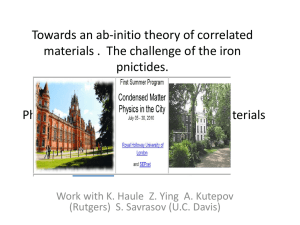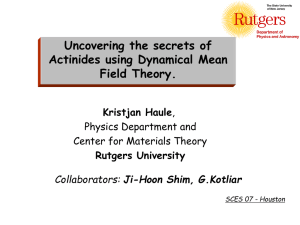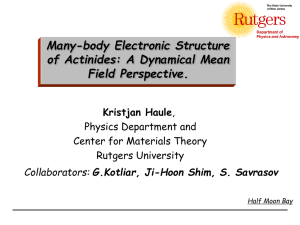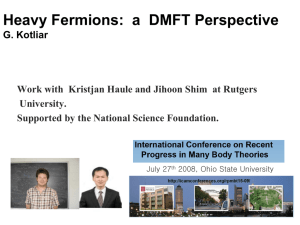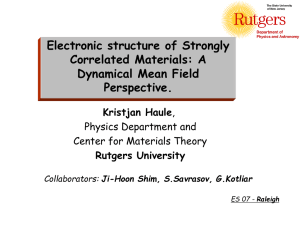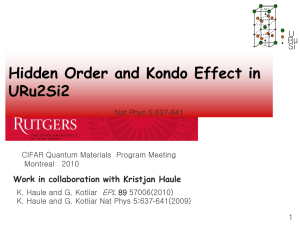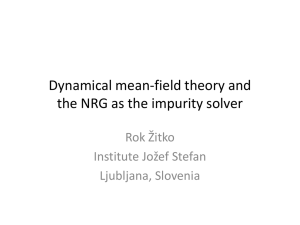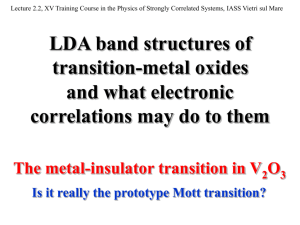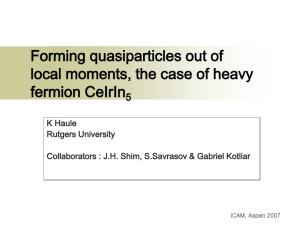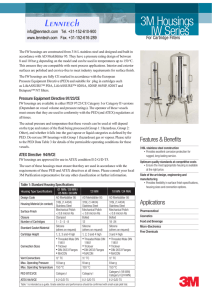ppt - Rutgers University
advertisement
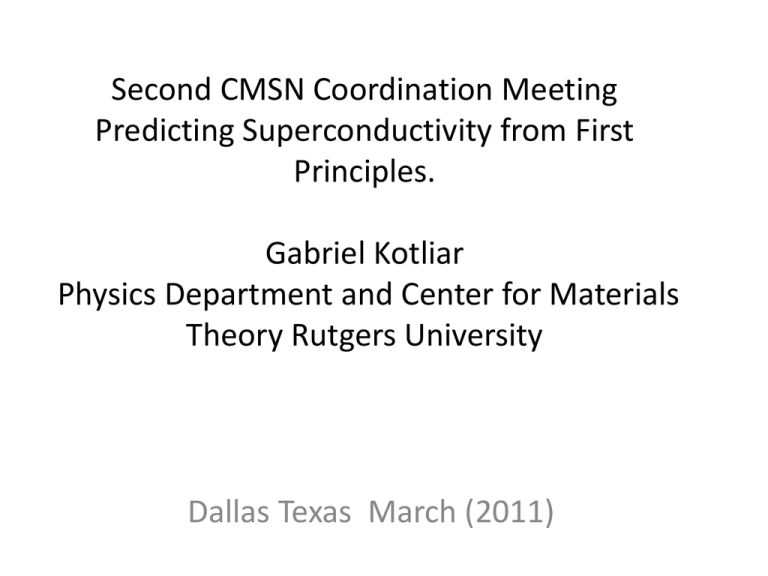
Second CMSN Coordination Meeting Predicting Superconductivity from First Principles. Gabriel Kotliar Physics Department and Center for Materials Theory Rutgers University Dallas Texas March (2011) Outline • • • • CMSN overview The DMFT strategy How it works for models Why it will work on pnictides. Scientific Challenge • Predict Non Phonon Mediated Superconducting Tc’s starting from first principles. • Signature Problem iron pnictides, CaFe2As2 CaFe2As2 under pressure A. Kreyssig et.al, arXiv: 0807.3032 CMSN network for correlated materials Collaborative Project. Shared Posdocs/Students RUTGERS IOWA DOE BES ARIZONA UC DAVIS Outline • • • • CMSN overview The DMFT strategy How it works for models Why it will work on pnictides. DMFT • Designed to treat strongly correlated electron materials [ for example Mott transition problem] but treats well many other situations…… MIGDAL-ELIASHBERG THEORY was the first (albeit aproximate) Dynamical Mean Field Theoryl • Designed to compute one electron spectral functions, photoemission and BIS • Designed to treat finite electronic temperature • Can in principle treat superconductivity and other orders • Combines ideas of physics (bands ) and chemistry (local CI) • It is a relatively new method. Still rapidly developing. Functional formulation of realistic DMFT PT in W and G [Chitra and GKotliar]. 1 1 [G,W ] TrLnG Tr[G01 G 1 ]G TrLnW Tr[VC1 W 1 ]W Ehartree [G,W ] 2 2 Introduce projector Gloc Wloc GW+DMFT Why it should work ? GW+DMFT proposed and fully implmented in the context of a a one orbital lattice model. P Sun and G. Kotliar Phys. Rev. B 66, 85120 (2002). Test various levels of self consistency in Gnonloc Pinonloc P.Sun and GK PRL (2004). S. Savrasov and GK [ PRB 2003] Biermann, F.Aryasetiawan. and A. Georges, PRL 90, 86402 (2003) Test notion of locality in LMTO basis set in various materials. N. Zeyn S. Savrasov and G. Kotliar PRL 96, 226403, (2006). Include higher order graphs, first implementation of GW+DMFT (with a perturbative impurity solver). GW self energy for Si Beyond GW 0.04 0.03 0.008 0.02 0.006 0.01 0.004 Sigma s GW Sigma p GW 0 -0.01 0.002 D Sigma s D Sigma p 0 -0.02 -0.002 -0.03 -0.004 -0.04 0 1 2 -0.006 0 Coordination Sphere 1 2 Coordination Sphere GW and DMFT DMFT 00 ( ) 00 ( ) GW 0 R ( ) 0 R ( ) R neq 0 . • P. Sun and G. Kotliar, PRB 66, 85120 (2002) • S. Biermann, F.Aryasetiawan. and A. Georges, PRL 90, 86402 (2003)[ Nickel !] • S. Savrasov and GK New Theoretical Approaches to Strongly Correlated Systems, A.M. Tsvelik Ed., Kluwer Academic Publishers 259-301, (2001) arXiv:cond-mat/0208241 LDA+DMFT as an approximation to the general GW+DMFT scheme S ® æ0 ç ç ç ç è0 ö 0 ÷ ÷ + ÷ ÷ S dmft ff - Edcø æ[Wloc ]spd ,sps [Wloc ]spd , f Wloc (iw) = ççç çè [Wloc ] f ,spd [Wloc ] ff æVxc[k ]spd ,sps ç ç ç ç Vxc[k ] f ,spd è é0 ù 0 ö ÷ ê ú ÷ ® ÷ ÷ ø ê0 Uabcd ú ë û Vxc[k ]spd , f Vxc[k ] ff U is parametrized in terms of Slater integrals F0 F2 F4 …. Recent calculations using B3LYP hybrid + DMFT for Ce2O3. D. Jacob K. Haule and GK EPL 84, 57009 (2008) Various implementations over the years, more precise basis sets, better projectors, better impurity solvers. Recent Work on determining U, and Edc using SC GW. 12 DMFT Phonons in fcc d-Pu ( Dai, Savrasov, Kotliar,Ledbetter, Migliori, Abrahams, Science, 9 May 2003) (experiments from Wong et.al, Science, 22 August 2003) Outline • • • • CMSN overview The DMFT strategy How it works for models Why it will work on pnictides. Hubbard model : plaquette in a medium. Lichtenstein and Kastnelson PRB (2000) 16 Link DMFT. Normal state Real Space Picture. Ferrero et. al. (2010) (similar to plaquette Haule and GK) (2006) Singlet formation. S (singlet),T (triplet) N=2 singlet, triplet E (empty) N=0 1+ states with 1 electron in + orb • Momentum Space Picture: High T Underdoped region: arcs shrink as T is reduced. Overdoped region FS sharpens as T is reduced. 17 Reminiscent of PW Anderson RVB Science 235, 1196 (1987) and slave Superexchange Mechanism? K. Haule and GK Phys. boson picture G. Kotliar and J. Liu P.RB 38,5412 (1988) . (2007). Ex=Rev. Jij(< BSi.76, Sj >104509 < Si . Sj>n)/t s How is the energy distributed in q and w ? D.J. Scalapino and S.R. White, Phys. Rev. B 58, 8222 (1998). Expts; Dai et.al. Early DMFT predictions Unconventional SC Phonon Tc<1K Importance of correlations Mass enhancement 3-5 How strong is local Coulomb repulsion? Calculations for BaFe2As2 with all valence states included in DMFT (not just d-orbitals) self consistent GW computation of U=(Wloc^-1+Pi_loc)^-1 A. Kutepov K. Haule S. Savrasov and G. Kotliar PRB 82, 045105 (2010) F0=U ~ 5eV But U does not give rise to correlations or sizable magnetic moment J-Hunds ~0.7-0.8eV Strongly enhances quasiparticle mass, Ordered magnetic moment very sensitive to J-Huds: Yin et. al. arXiv: 1007.2867 Correlation phase diagram and ordered moment of Hunds metals. Yin et al. Zhiping Yin et. al. 17 Neutron spectroscopy with LDA+DMFT Theory : H. Park , K. Haule and GK Experiments taken from arXiv:1011.3771 Next Step • Get a minimal cluster DMFT equations to derive superconductivity. • Crosscheck total energies with slave boson methods. [ interactions with Yonxing Xin and Jorg Schmalian (Iowa) , Xi Dai (Beijin)] • Crosscheck the vertex functions with those obtained with linear response [ Savrasov, Xiangan Wan] View from k space band theory. M X BaFe2As2 3 D. Singh and M. H Du arXiv:0803.0429 ) Cvektovic and Tezanovic arXiv:0804.4678) Building phase diagram magnetization at T=0 vs d. Single site Two site 19 Photoemission Havela et. al. Phys. Rev. B 68, 085101 (2003) K.Haule J. Shim and GK Nature 446, 513 (2007) Photoemission in Actinides alpa->delta volume collapse transition F0=4,F2=6.1 F0=4.5,F2=7.15 F0=4.5,F2=8.11 Curium has large magnetic moment and orders antiferromagnetically Pu does is non magnetic. N Zeyn S. Savrasov and G. K PRL 96, 226403 (2006) Cutoff Radius R Challenges • Optimal choice of projectors. • Basis sets [LMTO, LAPW, plane waves+PAW’s…..] • Optimal description of the “weakly correlated sector” [ dft , GW, hybrids ] • Cluster DMFT • Determination of the screened F0, F2, F4 FeSe1-0.08, (Tc=27K @ 1.48GPa), Mizuguchi et.al., arXiv: 0807.4315 Broad Range of Viewpoints • D. J Singh and M.H. Du Phys. Rev. Lett. 100, 237003 (2008). Itinerant magnetism. • LDA+Spin Fluctuations. • Haule K, Shim J H and Kotliar G Phys. Rev. Lett. 100, 226402 (2008) Correlated “Bad Semi-Metal” (U< Uc2) Multi-orbital model. Z ~0.2–0.3. • LDA+DMFT +extensions • Q.Si and E.Abrahams Phys. Rev. Lett. 101, 076401. (2008). Localized picture,frustration. • t-J model S=3/2 1/2 Importance of Hund’s coupling Hubbard U is not the “relevant” parameter. LaO1-0.1F0.1FeAs The Hund’s coupling brings correlations! Specific heat within LDA+DMFT for LaO1-0.1F0.1FeAs at U=4eV Prediction LDA value For J=0 there is negligible mass enhancement at U~W! The coupling between the Fe magnetic moment and the mean-field medium (As-p,neighbors Fe-d) becomes ferromagnetic for large Hund’s coupling! J~0.35 gives correct order ofMagnitude r. KHaule, G. Kotliar, Problem for us: Experimental evidences for weak correlations. NO SATELITES NOT SEEN • XES: no lower Hubbard band or sharp quasiparticle peak • XAS: XAS and RIXS spectra are each qualitatively similar to Fe metal • XPS: itinerant character of Fe 3d electrons • V. I. Anisimov, et al, PhysicaC 469, 442 (2009) • W. L. Yang, et al, PRB 80, 014508 (2009) • Soft underbelly of the approach when one approaches very itinerant systems... Many different estimates of the effective paramaters, U, J, etc in the literature, which leads to very different results. wc=3000cm-1 ~. .3 ev M. M. Qazilbash,1,, J. J. Hamlin,1 R. E. Baumbach,1 Lijun Zhang,2 D. J. Singh,2 M. B. Maple,1 and D. N. Basov1 Nature Physics 5, 647 (2009) Photoemission reveals now Z ~ .3 Freq. dep. U matrix well parametrized by F0 F2 F4 F0 = 4:9 eV, F2 = 6:4 eV and F4 = 4:3 eV., nc=6.2 Z =1/2 for x2- y2 and z2 , Z =1/3 f xz; yz zx orbitals. Theory: Kutepove et.al. Expt:. Qazilbash,et.al DMFT F0 = 4:9 eV, F2 = 6:4 eV and F4 = 4:3 eV., nc=6.2 DOS [kutepov et.al. 2010] There is transfer of spectral weight to high energies, spectral weight is conserved. But the DOS is featuresless no satellites, and resembles the LDA! Big difference between oxides and pnictides. Theory: Kutepov et.al. Expt Brouet et.al. Magnetic moment .95 muB LDA ~ 2 muB, expt 1 muB Photoemission Spectra DMFT Valence Histogram Kutepov et. al. (2010) Completely different than that of a weakly correlated metal Completely different from that of an oxide! The width is determined by F2 and F4 and the hybridization with As which is spread over many ev’s. All atomic states have weight! But the states are spread over a scale much larger than the bandwidth Some DMFT Reviews • K. Held. Adv. in Physics, 56:829, 2007. • A.Georges, G. K., W. Krauth and M. J. Rozenberg, Reviews of . Modern Physics 68, 13 (1996). • G. Kotliar S. Savrasov K. Haule O. Parcollet V.Oudvenko and C. Marianetti Reviews of Modern Physics 78, 865-951, (2006). • G. Kotliar and D. Vollhardt Physics Today, Vol 57, 53 (2004). Thanks for your Attention!! Kohn Sham Eigenvalues and Eigensates: Excellent starting point for perturbation theory in the screened interactions (Hedin 1965) G 1 1 0KS G +[ - VKS ] - Dynamical Mean Field Theory. Cavity Construction. A. Georges and G. Kotliar PRB 45, 6479 (1992). å J ij Si S j - h å Si i, j (t i , j , D (w) = ij H MF = - heff So i † H Anderson † Imp (V c0 A +c.c). d ij )(c c j c j ci ), U ni ni † i A A † , c0† c0 Uc0†c0c0† c0 , i å a * Va Va w - ea A() b b b ¶ c ( t )[ + m- D (t - t ')]cos (t ') + U ò no­ no¯ òò ¶ t 0 0 0 † os 10 Impurity Solver D ( w) ® A( w), ® Gimp (iwn ), atomic levels S (iwn )[D ] Machine for summing all local diagrams in PT in U to all orders. mi = th[b å J ij m j + h ] 1 iwn - S (iwn )[D ] B - D (iwn ) + Gimp (iwn )[D ] j Quantifying the degree of localization/delocalization Glatt (iwn , k )[D ] = 1 [iwn + m+ t (k ) - S imp (iwn )[D ]] Gimp (iwn )[D ] = å k G latt (iwn , k )[D ] 8 LDA+DMFT. V. Anisimov, A. Poteryaev, M. Korotin, A. Anokhin and G. Kotliar, J. Phys. Cond. Mat. 35, 7359 (1997). Lichtenstein and Katsnelson (1998) LDA++ 1 G ( k , i ) i t (k ) (i ) Spectra=- Im G(k,) U ®U S abcd t (k ) ® ® æ0 ö 0 ÷ çç ÷ ççè0 S ff - Edc÷ ÷ ø æH [k ]spd ,sps çç ççè H [k ] f ,spd | 0 > ,|­ > ,|¯> ,|­ ¯> ® Determine energy and and self consistently from extremizing a functional : the spectral density functional . Chitra and Kotliar (2001) . Savrasov and Kotliar (2001) Full self consistent implementation . Review: Kotliar et.al. RMP (2006) dft lda + dmf loc , G [r ] ¾ ¾ ®G t[G r ,U ] ö H [k ]spd , f ÷ ÷ ÷ H [k ] ff ÷ ø | LSJM J g... > 12 Main steps in DMFT • 1) Solve for atomic shell in a medium, Gloc Ploc loc and Wloc [Impurity Solver] • 2) Embed loc Ploc to obtain the solid greens functions. [Embedding] • 3) Project the full greens function to get the local greens function of the relevant shell. [Projection or Truncation] • 4) Recompute the medium in which the atom is embedded. [ Weiss fields] • Postprocessing: evaluate total energies, A(k,omega) sigma(omega) ……… Impurity Solver An exact impurity solver, continuous time QMC - expansion in terms of hybridization P. Werner et. al. PRL (2006) K.H.aule Phys. Rev. B 75, 155113 (2007) General impurity problem Diagrammatic expansion in terms of hybridization D +Metropolis sampling over the diagrams •Exact method: samples all diagrams! •Allows correct treatment of multiplets Same expansion using diagrammatics – real axis solver every atomic state represented with a unique pseudoparticle atomic eigenbase - full (atomic) base , where Luttinger Ward functional NCA OCA general AIM: SUNCA ( ) DMFT : the middle way • More expensive than density functional theory ( because it targets spectral properties) • Less expensive than direct application of QMC or CI (because it only uses these tools locally ) • Utilizes advances in electronic structure [ DMFT can be built on top of LDA, hybrid-DFT, GW ] and techniques such as QMC or CI, and its various levels of approx to solve the impurity problem. • Greens function method, based on a judicious use of the local approximation. Solved the Mott transition problem in the context of the model Hamiltonians. Goal, combine those ideas with technology from electronic structure methods to understand and predict properties of correlated materials. • Testing methods: “simple” models, experiments, predictive power ?
